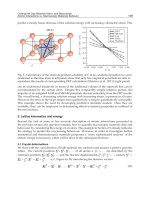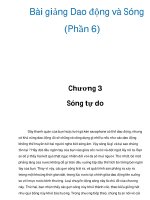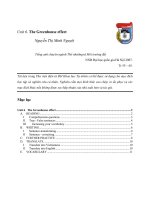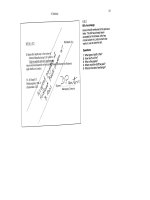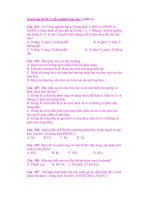Examples of VHDL Descriptions phần 6 pptx
Bạn đang xem bản rút gọn của tài liệu. Xem và tải ngay bản đầy đủ của tài liệu tại đây (30.53 KB, 9 trang )
Examples of VHDL Descriptions
WAIT FOR 20 us;
END PROCESS control_waves;
END block_struct;
Sinewave generator for testbench
entity to generate a 2.5kHz sampled sinewave (sampled at 20 us intervals)
USE WORK.adcpac.ALL;
ENTITY sinegen IS
PORT(sinewave : OUT analogue);
END sinegen;
ARCHITECTURE behaviour OF sinegen IS
CONSTANT ts : TIME := 20 us; sample interval
TYPE sinevals IS ARRAY (0 TO 5) OF analogue;
sample values for one quarter period
CONSTANT qrtrsine : sinevals := (0.0, 1.545, 2.939, 4.045, 4.755, 5.0);
BEGIN
PROCESS sequential process generates sinewave
BEGIN
FOR i IN 0 TO 19 LOOP output 20 samples per period
IF (i >= 0) AND (i < 6) THEN first quarter period
sinewave <= qrtrsine(i);
ELSIF (i >= 6) AND (i < 11) THEN second quarter period
sinewave <= qrtrsine(10-i);
ELSIF (i >= 11) AND (i < 16) THEN third quarter period
sinewave <= -qrtrsine(i-10);
ELSE i IN 16 TO 19
sinewave <= -qrtrsine(20-i); final quater period
END IF;
WAIT FOR ts;
END LOOP;
END PROCESS;
END behaviour;
Testbench for Digital Delay Unit
USE WORK.rampac.ALL;
USE WORK.adcpac.ALL;
ENTITY delay_bench IS
PORT(reset : IN BIT; delay : IN addr10);
END delay_bench;
ARCHITECTURE version1 OF delay_bench IS
COMPONENT sinegen
PORT(sinewave : OUT analogue);
END COMPONENT;
COMPONENT digdel2
PORT(clear : IN BIT; offset : IN addr10;
sigin : IN analogue; sigout : INOUT analogue);
END COMPONENT;
SIGNAL analogue_in, analogue_out : analogue;
BEGIN
sig_gen : sinegen PORT MAP(analogue_in);
delay_unit : digdel2 PORT MAP(reset, delay, analogue_in, analogue_out);
http://www.ami.bolton.ac.uk/courseware/adveda/vhdl/vhdlexmp.html (51 of 67) [23/1/2002 4:15:09 ]
Examples of VHDL Descriptions
END;
8-bit Analogue to Digital Converter
8-bit analogue to digital converter
demonstrates use of LOOP and WAIT statements
ENTITY adc8 IS
GENERIC(tconv : TIME := 10 us); conversion time
PORT(vin : IN REAL RANGE 0.0 TO +5.0; unipolar input
digout : OUT NATURAL RANGE 0 TO 255; output
sc : IN BIT; busy : OUT BIT); control
END adc8;
ARCHITECTURE behaviour OF adc8 IS
BEGIN
PROCESS
VARIABLE digtemp : NATURAL;
CONSTANT vlsb : REAL := 5.0/256; least significant bit value
BEGIN
digtemp := 0;
WAIT UNTIL (sc'EVENT AND sc = '0'); falling edge on sc starts conv
busy <= '1'; flag converter busy
WAIT FOR tconv; conversion time
FOR i IN 0 TO 255 LOOP do ramp-up conversion
IF vin >= REAL(i)*vlsb
THEN IF digtemp = 255 THEN EXIT;
ELSE digtemp := digtemp + 1;
END IF;
ELSE EXIT;
END IF;
END LOOP;
digout <= digtemp; output result
busy <= '0'; flag end of conversion
END PROCESS;
END behaviour;
8-bit Unipolar Successive Approximation ADC
8-bit unipolar successive approximation analogue to digital converter
demonstrates use of LOOP and WAIT statements
ENTITY adcsc8 IS
PORT(vin : IN REAL RANGE 0.0 TO +5.0; unipolar analogue input
digout : OUT BIT_VECTOR(7 DOWNTO 0); digital output
clock, sc : IN BIT; busy : OUT BIT); clock & control
END adcsc8;
ARCHITECTURE behaviour OF adcsc8 IS
SIGNAL v_estimate : REAL RANGE 0.0 TO +5.0;
http://www.ami.bolton.ac.uk/courseware/adveda/vhdl/vhdlexmp.html (52 of 67) [23/1/2002 4:15:09 ]
Examples of VHDL Descriptions
BEGIN
PROCESS
CONSTANT v_lsb : REAL := 5.0/256; least significant bit value
BEGIN
WAIT UNTIL (sc'EVENT AND sc = '0'); falling edge on sc starts conv
v_estimate <= 0.0; initialise v_estimate
digout <= "00000000"; clear SAR register
busy <= '1'; flag converter busy
FOR i IN digout'RANGE LOOP loop for each output bit
WAIT UNTIL (clock'EVENT AND clock = '1');
v_estimate <= v_estimate + (REAL(2**i))*v_lsb;
digout(i) <= '1';
WAIT UNTIL (clock'EVENT AND clock = '1');
IF v_estimate >= vin THEN
v_estimate <= v_estimate - (REAL(2**i))*v_lsb;
digout(i) <= '0';
END IF;
END LOOP;
busy <= '0'; flag end of conversion
END PROCESS;
END behaviour;
TTL164 Shift Register
ENTITY dev164 IS
PORT(a, b, nclr, clock : IN BIT;
q : BUFFER BIT_VECTOR(0 TO 7));
END dev164;
ARCHITECTURE version1 OF dev164 IS
BEGIN
PROCESS(a,b,nclr,clock)
BEGIN
IF nclr = '0' THEN
q <= "00000000";
ELSE
IF clock'EVENT AND clock = '1'
THEN
FOR i IN q'RANGE LOOP
IF i = 0 THEN q(i) <= (a AND b);
ELSE
q(i) <= q(i-1);
END IF;
END LOOP;
END IF;
END IF;
END PROCESS;
END version1;
Behavioural description of an 8-bit Shift Register
http://www.ami.bolton.ac.uk/courseware/adveda/vhdl/vhdlexmp.html (53 of 67) [23/1/2002 4:15:09 ]
Examples of VHDL Descriptions
8-bit universal shift register modelled using a process
ENTITY shftreg8 IS
PORT(clock, serinl, serinr : IN BIT; clock and serial inputs
mode : IN BIT_VECTOR(0 TO 1);
"00" : disabled; "10" : shift left; "01" : shift right; "11" : Parallel
load;
parin : IN BIT_VECTOR(0 TO 7); parallel inputs
parout : OUT BIT_VECTOR(0 TO 7)); parallel outputs
END shftreg8;
ARCHITECTURE behavioural OF shftreg8 IS
BEGIN
PROCESS
declare variable to hold register state
VARIABLE state : BIT_VECTOR(0 TO 7) := "00000000";
BEGIN
synchronise process to rising edges of clock
WAIT UNTIL clock'EVENT AND clock = '1';
CASE mode IS
WHEN "00" => state := state; disabled
WHEN "10" =>
FOR i IN 0 TO 7 LOOP shift
left
IF i = 7 THEN
state(i) := serinl;
ELSE
state(i) := state(i + 1);
END IF;
END LOOP;
WHEN "01" =>
FOR i IN 7 DOWNTO 0 LOOP shift
right
IF i = 0 THEN
state(i) := serinr;
ELSE
state(i) := state(i - 1);
END IF;
END LOOP;
WHEN "11" => state := parin; parallel
load
END CASE;
assign variable to parallel output port
parout <= state;
END PROCESS;
END behavioural;
Structural Description of an 8-bit Shift Register
ENTITY dtff IS
GENERIC(initial : BIT := '1'); initial value of q
PORT(d, clock : IN BIT; q : BUFFER BIT := initial);
END dtff;
ARCHITECTURE zero_delay OF dtff IS
BEGIN
q <= d WHEN (clock'EVENT AND clock = '1');
END zero_delay;
Structural model of an 8-bit universal shift register
makes use of D-type flip flop component and generate statement
ENTITY shftreg8 IS
PORT(clock, serinl, serinr : IN BIT; mode : IN BIT_VECTOR(0 TO 1);
parin : IN BIT_VECTOR(0 TO 7);
http://www.ami.bolton.ac.uk/courseware/adveda/vhdl/vhdlexmp.html (54 of 67) [23/1/2002 4:15:09 ]
Examples of VHDL Descriptions
parout : BUFFER BIT_VECTOR(0 TO 7));
END shftreg8;
ARCHITECTURE structural OF shftreg8 IS
COMPONENT dtff
GENERIC(initial : BIT := '1');
PORT(d, clock : IN BIT; q : BUFFER BIT := initial);
END COMPONENT;
FOR ALL : dtff USE ENTITY work.dtff(zero_delay);
SIGNAL datain : BIT_VECTOR(0 TO 7);
BEGIN
reg_cells : FOR i IN 0 TO 7
GENERATE
reg_stage : dtff GENERIC MAP ('0') PORT MAP (datain(i) , clock, parout(i));
lsb_stage : IF i = 0 GENERATE
datain(i) <= parin(i) WHEN mode = "00" ELSE serinl WHEN mode = "10"
ELSE parout(i + 1) WHEN mode = "01" ELSE parout(i);
END GENERATE;
msb_stage : IF i = 7 GENERATE
datain(i) <= parin(i) WHEN mode = "00" ELSE parout(i - 1) WHEN mode =
"10"
ELSE serinr WHEN mode = "01" ELSE parout(i);
END GENERATE;
middle_stages : IF (i > 0) AND (i < 7) GENERATE
datain(i) <= parin(i) WHEN mode = "00" ELSE parout(i - 1) WHEN mode =
"10"
ELSE parout(i + 1) WHEN mode = "01" ELSE parout(i);
END GENERATE;
END GENERATE;
END structural;
8-bit Unsigned Multiplier
library IEEE;
use IEEE.Std_logic_1164.all;
use IEEE.Std_logic_unsigned.all;
entity MUL8X8 is
port(A, B : in Std_logic_vector(7 downto 0);
PROD : out Std_logic_vector(15 downto 0));
end MUL8X8;
architecture SYNP of MUL8X8 is
begin
PROD <= A * B;
end SYNP;
n-bit Adder using the Generate Statement
ENTITY addn IS
GENERIC(n : POSITIVE := 3); no. of bits less one
PORT(addend, augend : IN BIT_VECTOR(0 TO n);
carry_in : IN BIT; carry_out, overflow : OUT BIT;
sum : OUT BIT_VECTOR(0 TO n));
END addn;
http://www.ami.bolton.ac.uk/courseware/adveda/vhdl/vhdlexmp.html (55 of 67) [23/1/2002 4:15:09 ]
Examples of VHDL Descriptions
ARCHITECTURE generated OF addn IS
SIGNAL carries : BIT_VECTOR(0 TO n);
BEGIN
addgen : FOR i IN addend'RANGE
GENERATE
lsadder : IF i = 0 GENERATE
sum(i) <= addend(i) XOR augend(i) XOR carry_in;
carries(i) <= (addend(i) AND augend(i)) OR
(addend(i) AND carry_in) OR
(carry_in AND augend(i));
END GENERATE;
otheradder : IF i /= 0 GENERATE
sum(i) <= addend(i) XOR augend(i) XOR carries(i-1);
carries(i) <= (addend(i) AND augend(i)) OR
(addend(i) AND carries(i-1)) OR
(carries(i-1) AND augend(i));
END GENERATE;
END GENERATE;
carry_out <= carries(n);
overflow <= carries(n-1) XOR carries(n);
END generated;
A Variety of Adder Styles
Single-bit adder
library IEEE;
use IEEE.std_logic_1164.all;
entity adder is
port (a : in std_logic;
b : in std_logic;
cin : in std_logic;
sum : out std_logic;
cout : out std_logic);
end adder;
description of adder using concurrent signal assignments
architecture rtl of adder is
begin
sum <= (a xor b) xor cin;
cout <= (a and b) or (cin and a) or (cin and b);
end rtl;
description of adder using component instantiation statements
Miscellaneous Logic Gates
use work.gates.all;
architecture structural of adder is
signal xor1_out,
and1_out,
and2_out,
or1_out : std_logic;
begin
xor1: xorg port map(
in1 => a,
in2 => b,
out1 => xor1_out);
xor2: xorg port map(
in1 => xor1_out,
in2 => cin,
out1 => sum);
and1: andg port map(
http://www.ami.bolton.ac.uk/courseware/adveda/vhdl/vhdlexmp.html (56 of 67) [23/1/2002 4:15:09 ]
Examples of VHDL Descriptions
in1 => a,
in2 => b,
out1 => and1_out);
or1: org port map(
in1 => a,
in2 => b,
out1 => or1_out);
and2: andg port map(
in1 => cin,
in2 => or1_out,
out1 => and2_out);
or2: org port map(
in1 => and1_out,
in2 => and2_out,
out1 => cout);
end structural;
N-bit adder
The width of the adder is determined by generic N
library IEEE;
use IEEE.std_logic_1164.all;
entity adderN is
generic(N : integer := 16);
port (a : in std_logic_vector(N downto 1);
b : in std_logic_vector(N downto 1);
cin : in std_logic;
sum : out std_logic_vector(N downto 1);
cout : out std_logic);
end adderN;
structural implementation of the N-bit adder
architecture structural of adderN is
component adder
port (a : in std_logic;
b : in std_logic;
cin : in std_logic;
sum : out std_logic;
cout : out std_logic);
end component;
signal carry : std_logic_vector(0 to N);
begin
carry(0) <= cin;
cout <= carry(N);
instantiate a single-bit adder N times
gen: for I in 1 to N generate
add: adder port map(
a => a(I),
b => b(I),
cin => carry(I - 1),
sum => sum(I),
cout => carry(I));
end generate;
end structural;
behavioral implementation of the N-bit adder
architecture behavioral of adderN is
begin
p1: process(a, b, cin)
variable vsum : std_logic_vector(N downto 1);
variable carry : std_logic;
begin
carry := cin;
http://www.ami.bolton.ac.uk/courseware/adveda/vhdl/vhdlexmp.html (57 of 67) [23/1/2002 4:15:09 ]
Examples of VHDL Descriptions
for i in 1 to N loop
vsum(i) := (a(i) xor b(i)) xor carry;
carry := (a(i) and b(i)) or (carry and (a(i) or b(i)));
end loop;
sum <= vsum;
cout <= carry;
end process p1;
end behavioral;
n-Bit Synchronous Counter
LIBRARY ieee;
USE ieee.Std_logic_1164.ALL;
USE ieee.Std_logic_unsigned.ALL;
ENTITY cntrnbit IS
GENERIC(n : Positive := 8);
PORT(clock, reset, enable : IN Std_logic;
count : OUT Std_logic_vector((n-1) DOWNTO 0));
END cntrnbit;
ARCHITECTURE v1 OF cntrnbit IS
SIGNAL count_int : Std_logic_vector((n-1) DOWNTO 0);
BEGIN
PROCESS
BEGIN
WAIT UNTIL rising_edge(clock);
IF reset = '1' THEN
count_int <= (OTHERS => '0');
ELSIF enable = '1' THEN
count_int <= count_int + 1;
ELSE
NULL;
END IF;
END PROCESS;
count <= count_int;
END v1;
Moore State Machine with Concurrent Output Logic
library ieee;
use ieee.std_logic_1164.all;
entity moore1 is port(
clk, rst: in std_logic;
id: in std_logic_vector(3 downto 0);
y: out std_logic_vector(1 downto 0));
end moore1;
architecture archmoore1 of moore1 is
type states is (state0, state1, state2, state3, state4);
signal state: states;
begin
moore: process (clk, rst) this process defines the next state only
begin
if rst='1' then
state <= state0;
elsif (clk'event and clk='1') then
case state is
when state0 =>
if id = x"3" then
state <= state1;
else
state <= state0;
http://www.ami.bolton.ac.uk/courseware/adveda/vhdl/vhdlexmp.html (58 of 67) [23/1/2002 4:15:09 ]
Examples of VHDL Descriptions
end if;
when state1 =>
state <= state2;
when state2 =>
if id = x"7" then
state <= state3;
else
state <= state2;
end if;
when state3 =>
if id < x"7" then
state <= state0;
elsif id = x"9" then
state <= state4;
else
state <= state3;
end if;
when state4 =>
if id = x"b" then
state <= state0;
else
state <= state4;
end if;
end case;
end if;
end process;
assign state outputs concurrently;
y <= "00" when (state=state0) else
"10" when (state=state1 or state=state3) else
"11";
end archmoore1;
Mealy State Machine with Registered Outputs
library ieee;
use ieee.std_logic_1164.all;
entity mealy1 is port(
clk, rst: in std_logic;
id: in std_logic_vector(3 downto 0);
y: out std_logic_vector(1 downto 0));
end mealy1;
architecture archmealy of mealy1 is
type states is (state0, state1, state2, state3, state4);
signal state: states;
begin
moore: process (clk, rst)
begin
if rst='1' then
state <= state0;
y <= "00";
elsif (clk'event and clk='1') then
case state is
when state0 =>
if id = x"3" then
state <= state1;
y <= "10";
else
state <= state0;
y <= "00";
end if;
when state1 =>
state <= state2;
http://www.ami.bolton.ac.uk/courseware/adveda/vhdl/vhdlexmp.html (59 of 67) [23/1/2002 4:15:09 ]

